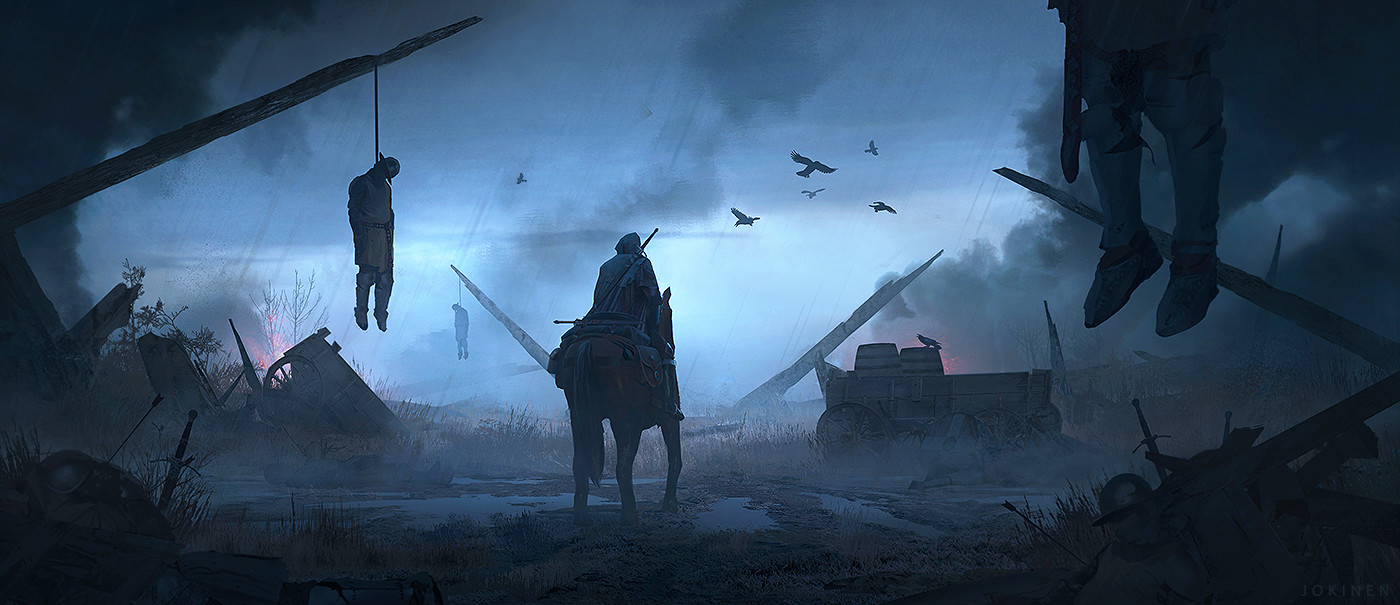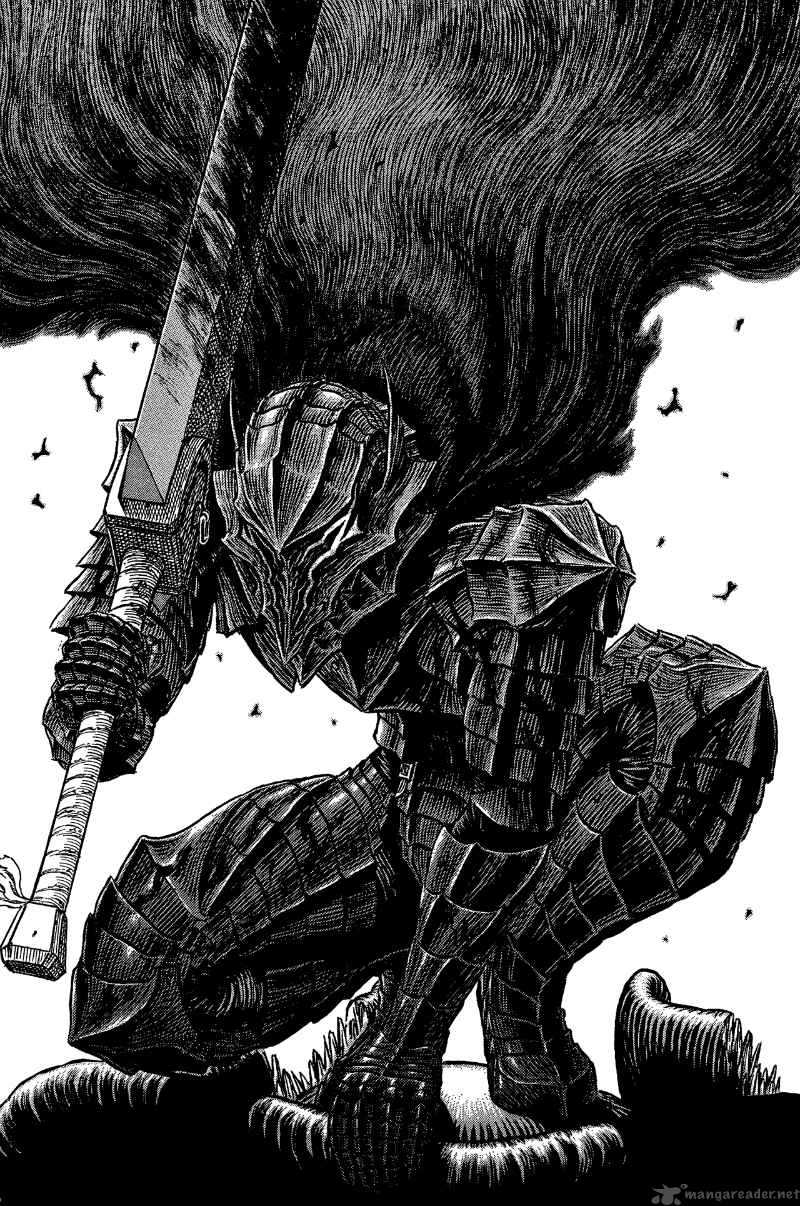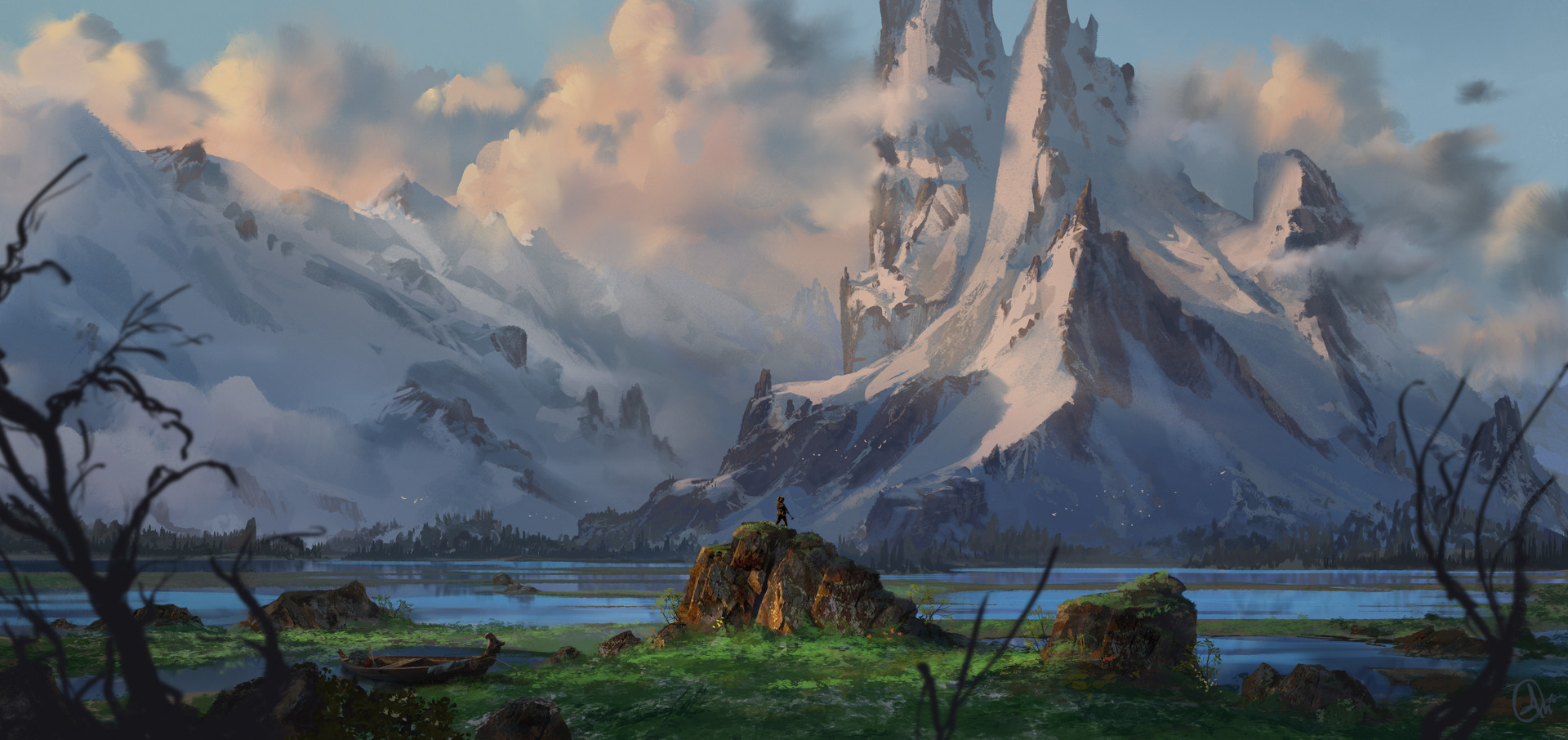 |
| The Sword Coast is plagued with battlefields. |
The pitch of the campaign is thus: the Sword Coast is named so not just for its cliffs, but for the neverending proxy wars that plague it. The City-States of the Lord's Alliance hire bands, sellswords, organizations, factions, guilds, and so on to invade ruins, fight off threats, and claim powerful spells for them. While every city-state has a standing army, using said standing army is a mistake when you can just pay a group of powerful individuals to invade a lich's lair and steal its staff. What makes these smaller groups more useful than an army is the Adventurer Phenomenon. For reasons unknown (though many theories exist in Candlekeep) these individuals, lovingly known as adventurers to the common people, are not what they once were. Years of traveling, fighting, killing, and strange magic has suffused them with the weave. A normal man cannot kill so many others within a six second period--even few elves, despite their great ages, gain the ability to call forth meteors from the sky.
In meta-terms, adventurer's become irradiated by the Weave as they work, and this makes them far more powerful than most mundanes, and even soldiers in armies, archwizards, and so forth. What keeps these same adventurer's from eventually taking over the world is how the city-state's use them against one another. Bands and guilds rush for the same prize for their city in order to get paid handsomely. There, they kill each other over what they want. A number of organizations--namely the Harper's--ensure that no group of adventurer's teams with another, tipping the power balance. It's an organized chaos, instrumental, where the Haves make the magically empowered Have Nots fight for wealth & fame in order to remain in power.
 |
| Adventurers are more like Guts, less like your normal heroes. |
The players are an adventuring band who must navigate the intense violence that is their lives. A lot of this campaign I want to examine what it means to kill things that are sentient, the weight that leaves on the soul, and the changes never-ending combat can scar otherwise good people with. Though I have a somewhat literary angle I want to explore with this campaign, I also want to embrace the hodgepodge of the Forgotten Realms. The races they picked, along with their classes, might mark them as "snowflakes" to many, but to me, the Forgotten Realms is at its best when players invoke the many races that make up its canon. That being said, my players also used the Xanathar's Guide to Everything to create a skeletal backstory; they rolled on the This Is Your Life table to give me some basic NPCs and conflicts with which to underscore this campaign with.
My players produced the following four characters they'll be starting with. I say starting, as I do expect death at some point:
Human Circle of the Moon Druid. A 52 year old woman who was always plagued with wolf dreams. Her father was a wandering scribe. Her mother, unknown. At puberty, her wolf dreams saw her become a lycan, and she murdered many people, including much of her family. In exile, she was adopted by a Circle of the Moon in the Moonwood. One of her siblings later joined on the same pretense. She lived as a hermit, even within her circle, and to their chargin, she used her herblore to help those who sought her out. She had a dwarven lover that the Circle of the Moon killed. She fled them, afraid of what they would do to her. They consistently chase her down, killing everyone she loves or bonds with out of revenge, and seeking to force her to return to them.
Githzerai Way of the Kensai Monk. A young gith born on the battlefield during an Illithid extermination mission. Said parents disappeared on this mission, leaving her to be raised by the specific monk order in Limbo that her parents were apart of. On one of her first missions, she compromised the mission to save another party member (mentioned below), leading to many of the gith dying and the Illithids escaping. This led to her exile by the order, which manifested as her being left stranded on the Material Plane. Later, she is saved by the same party member during a lycan attack in the Moonwood. The two hunted the lycan, and this is how they came into contact with the Moon Druid above.
Drow Enchantment Wizard. A young, female Drow, daughter to two escapees from the Underdark. Her mother abandoned her with her exiled sister, and his father is imprisoned--he could not escape his heritage, nor the xenophobia that others felt towards him for it. Her aunt taught her the magic of her blood and of the weave. She was saved by the GIthzerai Monk when an argument between her and a then lover led to a conflict exposing Illithid influence in the Silvered Marches. She later paid the favor back, and joined said Monk on their mission to kill the lycan that almost killed them.
Half-Elf Hexblade Warlock. A half-elf born to the planes and not the material world. Wolf dreams as a child infested him, much as they did the Moon Druid before, and eventually he became a lycan that was pulled by the wolf spirit in him to the Material World. There, he ravaged the Moonwood until the Druid player found him and stripped from him the wolf spirit, curing his lycanthropy. Said wolf spirit made a pact with the half-elf: "Allow me to act through you, and your penance shall be paid." In other words, by making this pact, the half-elf will kill all he considers evil, and thus "atone" for his sins as a lycan. A flawed ideal, but one that has joined him with the rest of the party.
Now then, with the characters described, I'll begin detailing the opening world for the campaign. It takes place in what is canonically Silverymoon and the Silver Marches. I've renamed these slightly to Silvermoon & the Silvered Marches, partially for aesthetic and partially for narrative.
Below is a primer of the Silvered Marches. Future blogposts will contain (in no particular order):
- Roll tables I create for my campaign running the region.
- Primers of the main cities.
- Legends, religions, myths, and beliefs of the region.
- Big factions/famed adventuring & mercenary bands.
- Dungeons I create
- Treasures & artifacts
- Play Reports
 |
| Werewolves haunt the Silvered Marches. |
SHORT PRIMER: LURUAR THE SILVERED MARCHES
Current Year: 1993 DR
Minted Coins: Slivers (5 copper pieces in other regions), Wanes (30 Slivers), Waxes (30 Wanes), Fulls (30 Waxes)
Life Style Brackets:
 |
| Statue of Silvadin, Who Wanes & Waxes |
- Squalid: Beggars who make nothing a day. Common in Silvermoon and Everlund, but not really elsewhere in the Silvered Marches.
- Poor: Making a 3 slivers a day, a wane a week, and 3 wanes a month. In the cities, enough for shared apartments, living in inns on the road, or owning and working your own farm in the southern settlements. Jobs: Lumberjacks, farmers, fishermen, starving artists, miners, waste disposal, odd jobs, cleaners, and other comparable jobs.
- Modest: Making 1 wane a day, 10 wanes a week, and a waxe a month. In the cities, enough for a studio apartment, an independent house outside the city, a nice manse in a southern settlement. Jobs: Apprentices to silversmiths & other trades, early career artisans, militiamen, fur traders, hunters, herbalists, head farmers, veteran farmworkers, servents, and other comparable jobs.
- Comfortable: Making 3 wane a day, a waxe a week, and 3 waxe a month. In the cities, a nice townhouse, living lavishly in the southern settlements. Jobs: Skilled artisans in guilds, artists of all stripes that are doing well; experienced silversmiths, alchemists, hunters, and blacksmiths; militia officers, many merchants, clerics.
- Wealthy: Making 5 waxe a day, 50 waxe a week, and 3 full a month. Manses in cities, complete with courtyards and servants. Fortified keeps in the southern settlements, though small. Jobs: Famed artists, vaunted merchants, legendary guild workers (including silversmiths, blacksmiths, alchemists, etc), apprentice wizards, adventurers, brewers, architects, and other highly skilled jobs.
- Aristocratic: Making 5 fulls a day, 50 fulls a week, and 150 fulls a month. They are disgustingly rich. Castles, keeps, whatever they want. Jobs: Landed nobles, wizards (enchanters, mainly), guild councilmen, owners of fur-trading and mining operations/businesses, incredibly skillful merchants, pontiffs, generals, and other such high brass positions.
Popular Faiths: The following faiths are the most well-known cults & religions in the Silvered Marches. Others exist, but with very few followers. Expect more info in future posts. Most people dedicate themselves to one main faith, while giving alms to the others in times of need or crisis.
- Lunagricultism - Worshippers of Chauntea (Goddess of Life/Agriculture/Summer) and Silvanus (God of Natural Cycles/Cataclysms/Deep Forests). Known regionally as Miada, Mother of Moonrises and Silvadin, Who Wanes and Waxes. A religion based around lunar cycles and life-giving.
- Moondancing - Worshipers of the Raven Queen (Goddess of Death/Forgotten Memories/Tragedies). Known locally as Quaca, Queen of New Moons. A religion based around rituals and festivals that put to rest the tragedy-chained souls of the Silvered Marches. Clerics are known curse breakers.
- Weavism - Worshippers of Mystra (Goddess of Magic/Spells/the Weave), Selûne (Goddess of the Moon/Silver/Questers), and Azuth (God of Magical Craft/Wizards/Arcane Study). Collectively and regionally known as the Three Scriptures. Each is considered less a god and more a process, act, or methodology.
- Smithians - Worshipers of Gond (God of Smithing/Silversmithing/Metalworking), Helm (God of Guardians/Protection/Vigilance), and Ilmater (Endurance/Martyrs/Perseverance). Collectively and regionally known as the Long Year. Each represents both 1/3 seasons (Summer/Winter/Thunder) as well as a defense of the Silver Marches (Silver Weapons/Land-Riders/Heroic Death).
Demographics for Non-Enemy Races: (On a two-axis system of Majority/Minority and Plentiful/Uncanny. Majority/Uncanny=in power, but smaller numbers. Minority/Plentiful=low social power, larger numbers) - (Races not mentioned below are one-offs and very rare in the Silvered Marches)
Common/Classical Races
- Humans - Majority/Plentiful
- Half-Elves - Majority/Plentiful
- Elves - Majority/Uncanny (Moon Elves)
- Dwarves - Majority/Uncanny (Shield Dwarves)
- Halflings - Minority/Plentiful (Ghostwise)
- Gnomes - Minority/Uncanny (Rock Gnomes)
- Half-Orc - Minority/Uncanny
Uncommon Races
- Aasimar/Tiefling (always born in twin sets) - Majority/Uncanny
- Goliath - Majority/Plentiful
- Firbolg - Minority/Uncanny
- Centaur - Minority/Uncanny
- Aarakocra - Majority/Uncanny
- Drow - Minority/Uncanny
Monster Races (from Volos) - All monster races are kill-on-sight unless they are marked with the Silver Badge, marking them as members of some adventuring guild or servant to some wizard or lord. For these races, the two-axis population categories are for their presence in the wilderness and not in the cities.
- Orks - Majority/Plentiful
- Bugbears - Minority/Uncanny
- Hobgoblins - Majority/Uncanny
- Goblins - Minority/Plentiful
- Kobolds - Minority/Uncanny
- Yuan-Ti Pureboods - Minority/Uncanny
 |
| Citadel Sundabar, the Last Dwarven Citadel |
Know her as Luruar, the Silvered Marches, where the moon is ever-full and the grounds ever hunted.
Religions dedicated to goddesses of magic, ancient deities of silver & wolves, and mysterious lords of bloodied mountains tell much of this land's history. Sense humanity first came to this northern strip--fertile, with clean rivers and deep silver mines--night-horrors have haunted them. Lycans have always lived in the Moonwood. Pale orks have always festered beneath gloom-black hills. Were it not for those same mines that humanity came here lusting for, they would have never been able to fight off these ills. But silver-smithed swords, silvered arrows, polished mirrors all have rebuked the forest and mountains, allowed for the placing of bricks for cities, allowed for culture to blossom where before there was just flesh torn from flesh. The marches are aptly named, too, for the constant battles over centuries against northern Jotun, pale ork hosts, and lycan hyper-packs that haunt her.
 |
| Foothills of the Nether Mountains. |
Dwarven Citadels sit abandoned along the Nether Mountains and the Rauvins. They were here before humanity, but they could not last. Betrayed too many times for too many causes both just and foul, the dwarves fell to a never-ending, always-boiling host of pale orks, dragon-worshipping hobgoblins, lycan raids, and their own greed. Their citadels are now ghost-cities. Only one remains: the curse'd Sundabar. Treeless, soulless, here prisoners are sent alongside adventuring parties to wage wars that ply deep into the earth in exchange for silver, gold, gem-enslaved fire elementals, and the blood-night magick stolen from orks pale & horrid.
Two massive woods sprawl across Luruar. The always-mentioned Moonwood is the haunt of lycans, druids, and ghosts wracked by tragedy. The only animals in this forest are worgs, direwolves, and lesser wolves. Everything else is a spirit as well. These same spirits, at night, can be devoured, and their flesh youthens those that consume them. Thus, the Moonwood's wolf packs are old as elves and large as armies. Druids there worship them, sleep with them, care for them, and in turn are taught buy them the secrets of the moon. But for reasons known not to outsiders, these forces leave not the Moonwood less something truly foul boils from the roots of the Nether Mountains which they border. Every month, when the moon goes black, three tons of silver are offered to the Moonwood. When the moon returns, trees old have marched from the heart of the forest to be cut down, and old wolves are hung from the branches to be skinned. This pact, forged by the 1st Silverhand ages ago, has remained the lifeblood for the capital city-state of Silvermoon.
The Coldwood bordering Luruar's northern reaches is untouched by all. The evergreens here are all dyed white, the ground ever-frozen. What dwells within is known: Jotun-children, or as they call themselves, the Ettin. These two-headed giant-descendents have no society as humanity recognizes it. Instead, they are scattered, underground-dwelling hunters who live off direwolf and rothe flesh, and the flesh of any who venture within. Twice a year the capital city-state of Silvermoon launches powerful adventure groups into the Coldwood. Those that return come back with goods the Ettin have plundered, enough furs to help buoy the economy, and enough time for lumberjacks to pull lumber from those hills before both cold and monster grow too savage to stay.
 |
| A silvered adventurer meets an ancient dire wolf in the Moonwood. |
Luruar's southern lands are long-since tamed. The High Forest, Far Forest, and Lost Peaks have become farm fields and silver-mining operations. Silvermoon sits at the fett of the Nether Mountains, ruling as a powerful magocracy that holds the Silvered Marches together. Other large settlements include Sundabar (mentioned above), the walled merchant-city of Everlund, and the hunting halls of Jalanthar. Settlements in the worklands support the 4 Silvered Cities, and tribal nomads north of the Nether Mountains hunt and sell to further supplement the economy. Rivers bring in textiles, steel, and other "cultured" goods, bought usually with silver, weapons, armors, and foodstuffs (namely beef, goat, milk, cheese, ale, and nuts).
I like this idea of a Forgotten Realms Redux. The thematic through-line and politics of your take on the setting is interesting, and reminds me a bit of the anime Goblin Slayer (and is somewhat similar to some of my ideas for my Aquarian Dawn setting). I am reasonably familiar with Forgotten Realms for someone who hasn't played much in it, but I don't have a good sense of what, if any, subtext or themes exist in it. Are your themes meant to be a subversion of the setting, or more a subversion of tabletop fantasy tropes in general?
ReplyDeleteIncidentally, I 100% agree with your statement about the canonical races of Forgotten Realms! When people talk about anything not generic being a "snowflake", I wonder why they are even playing FANTASY. If your imagination is limited to just the shit someone else created in a book you read when you were a kid, it's not fantasy anymore, it's empty calorie nostalgia at best, it's trite and mundane. The Gith are hands down my favorite thing in Forgotten Realms, and I think it's a shame we don't see more of that "flavor" permeated throughout traditional fantasy.
There are no direct themes in the Forgotten Realms. Everything I'm drawing on is either a theme that can be applied after certain theoretical lens are applied, or me wanting to take the symbols present and add my own meaning to them. I don't aim for a direct subversion of the trope or the setting, though I'm sure at some levels a subversion will happen!
Delete